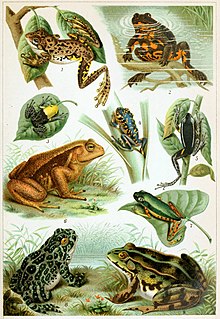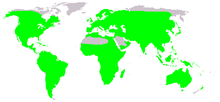Anuran
|
Frogs Temporal range: Early Jurassic - Present, 200–0 Ma |
|
|---|---|
 |
|
| Various types of frogs. | |
| Scientific classification | |
| Kingdom: | Animalia |
| Phylum: | Chordata |
| Class: | Amphibia |
| Clade: | Salientia |
| Order: |
Anura Duméril, 1806 (as Anoures) |
| Suborders | |
|
Archaeobatrachia |
|
 |
|
| Native distribution of frogs (in green) | |
Archaeobatrachia
Mesobatrachia
Neobatrachia
–
List of Anuran families
A frog is any member of a diverse and largely carnivorous group of short-bodied, tailless amphibians composing the order Anura (Ancient Greek an-, without + oura, tail). The oldest fossil "proto-frog" appeared in the early Triassic of Madagascar, but molecular clock dating suggests their origins may extend further back to the Permian, 265 million years ago. Frogs are widely distributed, ranging from the tropics to subarctic regions, but the greatest concentration of species diversity is in tropical rainforests. There are approximately 4,800 recorded species, accounting for over 85% of extant amphibian species. They are also one of the five most diverse vertebrate orders.
The body plan of an adult frog is generally characterized by a stout body, protruding eyes, cleft tongue, limbs folded underneath, and the absence of a tail in adults. Besides living in fresh water and on dry land, the adults of some species are adapted for living underground or in trees. The skin of the frog is glandular, with secretions ranging from distasteful to toxic. Warty species of frog tend to be called toads but the distinction between frogs and toads is based on informal naming conventions concentrating on the warts rather than taxonomy or evolutionary history; some toads are more closely related to frogs than to other toads. Frogs' skins vary in colour from well-camouflaged dappled brown, grey and green to vivid patterns of bright red or yellow and black to advertise toxicity and warn off predators.
...
Wikipedia
